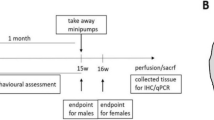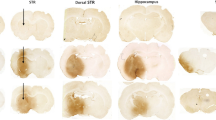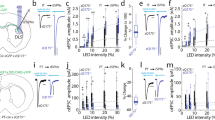Abstract
Maintenance and plasticity of striatal neurons is dependant on brain-derived neurotrophic factor (BDNF), which is depleted in the Huntington's disease striatum due to reduced expression and disrupted corticostriatal transportation. In this study we demonstrate that overexpression of BDNF in the striatum attenuates motor impairment and reduces the extent of striatal damage following quinolinic acid lesioning. Transfer of the BDNF gene to striatal neurons using serotype 1/2 adeno-associated viral vectors enhanced BDNF protein levels in the striatum, but induced weight loss and seizure activity following long-term high-level expression. Lower concentration BDNF expression supported striatal neurons against excitotoxic insult, as demonstrated by enhanced krox-24 immunopositive neuron survival, reduction of striatal atrophy and maintenance of the patch/matrix organization. Additionally, BDNF expression attenuated motor impairment in the forelimb use cylinder test, sensorimotor neglect in the corridor food selection task and reversed apomorphine-induced rotational behaviour. Direct correlations were shown for the first time between BDNF-mediated attenuation of behavioural impairment and the integrity of the globus pallidus, seemingly independent from the severity of striatal lesioning. These results demonstrate that BDNF holds considerable therapeutic potential for alleviating both neuropathological and motor function deficits in the Huntington's disease brain, and the critical role of pallidal neurons in facilitating motor performance.
This is a preview of subscription content, access via your institution
Access options
Subscribe to this journal
Receive 12 print issues and online access
$259.00 per year
only $21.58 per issue
Buy this article
- Purchase on Springer Link
- Instant access to full article PDF
Prices may be subject to local taxes which are calculated during checkout







Similar content being viewed by others
References
Kells AP, Fong DM, Dragunow M, During MJ, Young D, Connor B . AAV-mediated gene delivery of BDNF or GDNF is neuroprotective in a model of Huntington disease. Mol Ther 2004; 9: 682–688.
Perez-Navarro E, Canudas AM, Akerund P, Alberch J, Arenas E . Brain-derived neurotrophic factor, neurotrophin-3, and neurotrophin-4/5 prevent the death of striatal projection neurons in a rodent model of Huntington's disease. J Neurochem 2000; 75: 2190–2199.
Martinez-Serrano A, Bjorklund A . Protection of the neostriatum against excitotoxic damage by neurotrophin-producing, genetically modified neural stem cells. J Neurosci 1996; 16: 4604–4616.
Bemelmans AP, Horellou P, Pradier L, Brunet I, Colin P, Mallet J . Brain-derived neurotrophic factor-mediated protection of striatal neurons in an excitotoxic rat model of Huntington's disease, as demonstrated by adenoviral gene transfer. Hum Gene Ther 1999; 10: 2987–2997.
McBride JL, During MJ, Wuu J, Chen EY, Leurgans SE, Kordower JH . Structural and functional neuroprotection in a rat model of Huntington's disease by viral gene transfer of GDNF. Exp Neurol 2003; 181: 213–223.
McBride JL, Ramaswamy S, Gasmi M, Bartus RT, Herzog CD, Brandon EP et al. Viral delivery of glial cell line-derived neurotrophic factor improves behavior and protects striatal neurons in a mouse model of Huntington's disease. Proc Natl Acad Sci USA 2006; 103: 9345–9350.
Popovic N, Maingay M, Kirik D, Brundin P . Lentiviral gene delivery of GDNF into the striatum of R6/2 Huntington mice fails to attenuate behavioral and neuropathological changes. Exp Neurol 2005; 193: 65–74.
Emerich DF, Lindner MD, Winn SR, Chen EY, Frydel BR, Kordower JH . Implants of encapsulated human CNTF-producing fibroblasts prevent behavioral deficits and striatal degeneration in a rodent model of Huntington's disease. J Neurosci 1996; 16: 5168–5181.
Emerich DF, Cain CK, Greco C, Saydoff JA, Hu ZY, Liu H et al. Cellular delivery of human CNTF prevents motor and cognitive dysfunction in a rodent model of Huntington's disease. Cell Transplant 1997; 6: 249–266.
Mittoux V, Ouary S, Monville C, Lisovoski F, Poyot T, Conde F et al. Corticostriatopallidal neuroprotection by adenovirus-mediated ciliary neurotrophic factor gene transfer in a rat model of progressive striatal degeneration. J Neurosci 2002; 22: 4478–4486.
Mittoux V, Joseph JM, Conde F, Palfi S, Dautry C, Poyot T et al. Restoration of cognitive and motor functions by ciliary neurotrophic factor in a primate model of Huntington's disease. Hum Gene Ther 2000; 11: 1177–1187.
de Almeida LP, Zala D, Aebischer P, Deglon N . Neuroprotective effect of a CNTF-expressing lentiviral vector in the quinolinic acid rat model of Huntington's disease. Neurobiol Dis 2001; 8: 433–446.
Ferrer I, Goutan E, Marin C, Rey MJ, Ribalta T . Brain-derived neurotrophic factor in Huntington disease. Brain Res 2000; 866: 257–261.
Zuccato C, Ciammola A, Rigamonti D, Leavitt BR, Goffredo D, Conti L et al. Loss of huntingtin-mediated BDNF gene transcription in Huntington's disease. Science 2001; 293: 493–498.
Zuccato C, Tartari M, Crotti A, Goffredo D, Valenza M, Conti L et al. Huntingtin interacts with REST/NRSF to modulate the transcription of NRSE-controlled neuronal genes. Nat Genet 2003; 35: 76–83.
Zuccato C, Liber D, Ramos C, Tarditi A, Rigamonti D, Tartari M et al. Progressive loss of BDNF in a mouse model of Huntington's disease and rescue by BDNF delivery. Pharmacol Res 2005; 52: 133–139.
Gauthier LR, Charrin BC, Borrell-Pages M, Dompierre JP, Rangone H, Cordelieres FP et al. Huntingtin controls neurotrophic support and survival of neurons by enhancing BDNF vesicular transport along microtubules. Cell 2004; 118: 127–138.
del Toro D, Canals JM, Gines S, Kojima M, Egea G, Alberch J . Mutant huntingtin impairs the post-Golgi trafficking of brain-derived neurotrophic factor but not its Val66Met polymorphism. J Neurosci 2006; 26: 12748–12757.
Baquet ZC, Gorski JA, Jones KR . Early striatal dendrite deficits followed by neuron loss with advanced age in the absence of anterograde cortical brain-derived neurotrophic factor. J Neurosci 2004; 24: 4250–4258.
Marty S, Berzaghi MdaP, Berninger B . Neurotrophins and activity-dependent plasticity of cortical interneurons. Trends Neurosci 1997; 20: 198–202.
Aoki C, Wu K, Elste A, Len G, Lin S, McAuliffe G et al. Localization of brain-derived neurotrophic factor and TrkB receptors to postsynaptic densities of adult rat cerebral cortex. J Neurosci Res 2000; 59: 454–463.
Canals JM, Pineda JR, Torres-Peraza JF, Bosch M, Martin-Ibanez R, Munoz MT et al. Brain-derived neurotrophic factor regulates the onset and severity of motor dysfunction associated with enkephalinergic neuronal degeneration in Huntington's disease. J Neurosci 2004; 24: 7727–7739.
Pineda JR, Canals JM, Bosch M, Adell A, Mengod G, Artigas F et al. Brain-derived neurotrophic factor modulates dopaminergic deficits in a transgenic mouse model of Huntington's disease. J Neurochem 2005; 93: 1057–1068.
Pang TY, Stam NC, Nithianantharajah J, Howard ML, Hannan AJ . Differential effects of voluntary physical exercise on behavioral and brain-derived neurotrophic factor expression deficits in Huntington's disease transgenic mice. Neuroscience 2006; 141: 569–584.
Spires TL, Grote HE, Varshney NK, Cordery PM, van Dellen A, Blakemore C et al. Environmental enrichment rescues protein deficits in a mouse model of Huntington's disease, indicating a possible disease mechanism. J Neurosci 2004; 24: 2270–2276.
Lynch G, Kramar EA, Rex CS, Jia Y, Chappas D, Gall CM et al. Brain-derived neurotrophic factor restores synaptic plasticity in a knock-in mouse model of Huntington's disease. J Neurosci 2007; 27: 4424–4434.
Borrell-Pages M, Canals JM, Cordelieres FP, Parker JA, Pineda JR, Grange G et al. Cystamine and cysteamine increase brain levels of BDNF in Huntington disease via HSJ1b and transglutaminase. J Clin Invest 2006; 116: 1410–1424.
Richichi C, Lin EJ, Stefanin D, Colella D, Ravizza T, Grignaschi G et al. Anticonvulsant and antiepileptogenic effects mediated by adeno-associated virus vector neuropeptide Y expression in the rat hippocampus. J Neurosci 2004; 24: 3051–3059.
MacGibbon GA, Lawlor PA, Hughes P, Young D, Dragunow M . Differential expression of inducible transcription factors in basal ganglia neurons. Brain Res Mol Brain Res 1995; 34: 294–302.
Herdegen T, Kovary K, Buhl A, Bravo R, Zimmermann M, Gass P . Basal expression of the inducible transcription factors c-Jun, JunB, JunD, c-Fos, FosB, and Krox-24 in the adult rat brain. J Comp Neurol 1995; 354: 39–56.
Schallert T, Fleming SM, Leasure JL, Tillerson JL, Bland ST . CNS plasticity and assessment of forelimb sensorimotor outcome in unilateral rat models of stroke, cortical ablation, parkinsonism and spinal cord injury. Neuropharmacology 2000; 39: 777–787.
Dowd E, Monville C, Torres EM, Dunnett SB . The corridor task: a simple test of lateralised response selection sensitive to unilateral dopamine deafferentation and graft-derived dopamine replacement in the striatum. Brain Res Bull 2005; 68: 24–30.
Schwarcz R, Fuxe K, Agnati LF, Hokfelt T, Coyle JT . Rotational behaviour in rats with unilateral striatal kainic acid lesions: a behavioural model for studies on intact dopamine receptors. Brain Res 1979; 170: 485–495.
Hauck B, Chen L, Xiao W . Generation and characterization of chimeric recombinant AAV vectors. Mol Ther 2003; 7: 419–425.
Croll SD, Suri C, Compton DL, Simmons MV, Yancopoulos GD, Lindsay RM et al. Brain-derived neurotrophic factor transgenic mice exhibit passive avoidance deficits, increased seizure severity and in vitro hyperexcitability in the hippocampus and entorhinal cortex. Neuroscience 1999; 93: 1491–1506.
Scharfman HE . Hyperexcitability in combined entorhinal/hippocampal slices of adult rat after exposure to brain-derived neurotrophic factor. J Neurophysiol 1997; 78: 1082–1095.
Pelleymounter MA, Cullen MJ, Wellman CL . Characteristics of BDNF-induced weight loss. Exp Neurol 1995; 131: 229–238.
Kernie SG, Liebl DJ, Parada LF . BDNF regulates eating behavior and locomotor activity in mice. EMBO J 2000; 19: 1290–1300.
Kaspar BK, Erickson D, Schaffer D, Hinh L, Gage FH, Peterson DA . Targeted retrograde gene delivery for neuronal protection. Mol Ther 2002; 5: 50–56.
Greengard P, Allen PB, Nairn AC . Beyond the dopamine receptor: the DARPP-32/protein phosphatase-1 cascade. Neuron 1999; 23: 435–447.
Bibb JA, Yan Z, Svenningsson P, Snyder GL, Pieribone VA, Horiuchi A et al. Severe deficiencies in dopamine signaling in presymptomatic Huntington's disease mice. Proc Natl Acad Sci USA 2000; 97: 6809–6814.
McGeorge AJ, Faull RL . The organization of the projection from the cerebral cortex to the striatum in the rat. Neuroscience 1989; 29: 503–537.
Gerfen CR . The neostriatal mosaic. I. Compartmental organization of projections from the striatum to the substantia nigra in the rat. J Comp Neurol 1985; 236: 454–476.
During MJ, Young D, Baer K, Lawlor P, Klugmann M . Development and optimization of adeno-associated virus vector transfer into the central nervous system. Methods Mol Med 2003; 76: 221–236.
Timpe J, Bevington J, Casper J, Dignam JD, Trempe JP . Mechanisms of adeno-associated virus genome encapsidation. Curr Gene Ther 2005; 5: 273–284.
Kells AP, Henry RA, Hughes SM, Connor B . Verification of functional AAV-mediated neurotrophic and anti-apoptotic factor expression. J Neurosci Methods 2007; 161: 291–300.
Author information
Authors and Affiliations
Corresponding author
Rights and permissions
About this article
Cite this article
Kells, A., Henry, R. & Connor, B. AAV–BDNF mediated attenuation of quinolinic acid-induced neuropathology and motor function impairment. Gene Ther 15, 966–977 (2008). https://doi.org/10.1038/gt.2008.23
Received:
Revised:
Accepted:
Published:
Issue Date:
DOI: https://doi.org/10.1038/gt.2008.23
Keywords
This article is cited by
-
Cerebral dopamine neurotrophic factor (CDNF) protects against quinolinic acid-induced toxicity in in vitro and in vivo models of Huntington’s disease
Scientific Reports (2020)
-
Excitotoxic neurodegeneration is associated with a focal decrease in metabotropic glutamate receptor type 5 availability: an in vivo PET imaging study
Scientific Reports (2019)
-
AAV1/2-mediated BDNF gene therapy in a transgenic rat model of Huntington’s disease
Gene Therapy (2016)
-
Human Mesenchymal Stem Cells Genetically Engineered to Overexpress Brain-derived Neurotrophic Factor Improve Outcomes in Huntington's Disease Mouse Models
Molecular Therapy (2016)
-
Striatal Microinjection of Sydenham Chorea Antibodies: Using a Rat Model to Examine the Dopamine Hypothesis
Journal of Molecular Neuroscience (2012)



